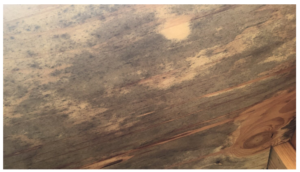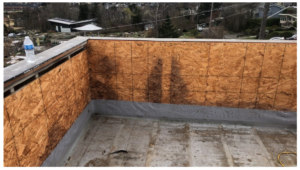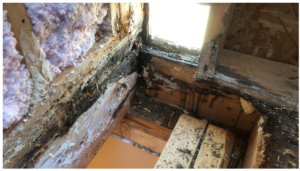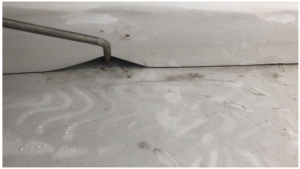Flat roofs are popular roofing style for many designs of homes. They can provide extra living spaces or add unique designs to contemporary homes. Flat roofs can be completed with a number of different materials as well. From your “hot mop” flat roofs to “TPO”, flat roofs are just like all other roofs and require maintenance, repairs, and replacement as they age. This article will go over 3 common issues that can be found on flat roofs.
Improper Venting:

Picture shows organic growth under a sheet of plywood in a improperly vented flat roof
One of primary purposes of the ventilation of for all roofs is to help dry out attic space from condensation that gets trapped in the attic from conditions inside and outside the home. Failure to adequately ventilate can lead to:
- Organic growth (also known as mold!)
- Expensive repairs to the substrate
- Damage to the insulation
- Damage to the drywall inside the home
These issues can be very hard to identify in a flat roof since typically there is no attic spaces to crawl inside. To compound this a lot of places don’t work on flat roofs regularly so when problems occur they are ill equipped with diagnosing the problem.
Improper Flashing Detail:

Damage to a flat roof due to failed flashings

Damage of failed flashing inside the flat roofing cavity
Flashings are the most important, and most overlooked part of any roofing system. They are the components that divert the water away from the openings in your roof that are prone to leaking. In flat roof installs, where sitting water can be normal flashing play a pivotal part in keeping your home dry. Improper flashed areas of a flat roof can cause damage not just to the roof but the entire home.
Loose Seams:

Picture shows what a loose seam can look like on TPO Flat Roof
Most flat roofs are installed by creating seams of roofing materials that when done correctly prevents sitting water from getting between the layers of roofing material. When this processed is rushed, not properly measured and lined up, it creates areas that will fail. These areas become easy areas for water to gain access into your roofing system.
These three common mistakes can be avoided by hiring a certified contractor. On part two of our segment on flat roofs, we will go over what questions to ask and what to look for when considering a flat roof.